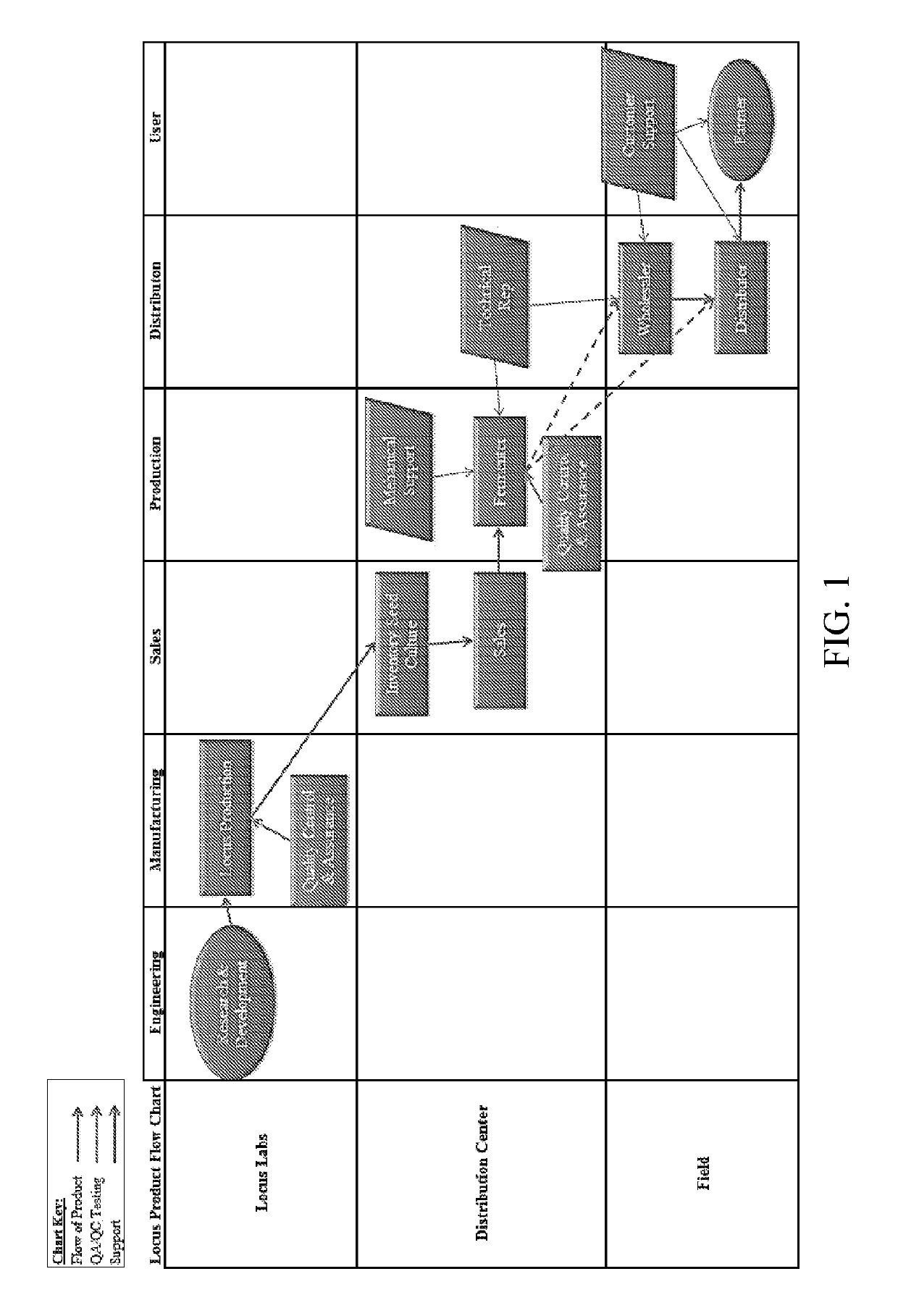Distributed systems for the efficient production and use of microbe-based compositions
a technology of distribution systems and compositions, applied in the direction of drug compositions, biocide, biomass after-treatment, etc., can solve the problems of affecting the quality of the product, the occurrence of microorganisms in the environment, and the inability to meet the needs of the customer, etc., to achieve the effect of facilitating custom production, and reducing the number of production lines
- Summary
- Abstract
- Description
- Claims
- Application Information
AI Technical Summary
Benefits of technology
Problems solved by technology
Method used
Image
Examples
example 1
ion of Starmerella Bombicola for Sophorolipid (SLP) Production in a 110 L Distributable Reactor
[0189]A portable, airlift-type, fully enclosed reactor operated by PLC with water filtration, temperature control unit, and an air blower on board is used. The reactor has a working volume of 90 L when growing S. bombicola for SLP production.
[0190]In preferred embodiments, the nutrients for SLP production are glucose, urea, yeast extract, canola oil, magnesium sulfate, and potassium phosphate.
[0191]The reactor is inoculated with 8 liters of liquid culture grown in flasks. The duration of the cultivation cycle for SLP production is 7-8 days, at 25° C. and pH 3.5, with sampling performed twice a day.
[0192]The final concentration of SLP is roughly 10% of working volume, in this case about 9 L of product, containing 300-400 grams of SLP per liter.
Example 2: Fermentation of Wickerhamomyces and / or Pichia Yeast for Sophorolipid Production in a 450 L Distributable Reactor
[0193]A movable airlift re...
example 4
ion of Wickerhamomyces and / or Pichia Yeast for Cell and Single Cell Protein Production in 2000 L Distributable Reactor
[0201]A portable reactor divided into two square tanks accompanied with 2 loops for mass exchange between them is used. The reactor has a working volume of 2000 L when growing Wickerhamornyces and / or Pichia for cell production.
[0202]In a preferred embodiment, the nutrients for cell production are glucose or baking sugar, urea, yeast extract, magnesium sulfate, and potassium phosphate.
[0203]The reactor is inoculated with 2% of seed culture. Fermentation continues for 48-72 hours with no pH stabilization, and a temperature of 26 to 32° C.
[0204]The final concentration of cells will be 100 g of wet weight per liter. Wet biomass concentration can reach up to 200 kilos per cycle with protein concentration up to 100 kilos.
example 5
ic Fermentation of a Combined Culture of Acinetobacter Venetianus and Bacillus subtilis in a 900 L Distributable Reactor
[0205]A portable reactor divided into two tanks run by a central airlift to help mix the two tanks simultaneously is used. The reactor has a working volume of 600 L when growing Acinetobacter / Bacillus subtilis for biosurfactant production.
[0206]In a preferred embodiment, the nutrients for biosurfactant production are glucose, powder molasses, sucrose, potassium phosphate, sodium phosphate, potassium chloride, magnesium sulfate, calcium chloride, urea, ammonium chloride, and yeast extract.
[0207]The reactor containing 600 L of nutrient medium with pH 6.8-7.0 is inoculated with 60 liters of seed culture containing both Acinetobacter and Bacillus subtilis. Fermentation continues for 24 hours with no pH stabilization, and a temperature of 28 to 30° C.
[0208]The final concentration of cells will be up to 1 billion cells of combined culture with approximate equal distribut...
PUM
 Login to View More
Login to View More Abstract
Description
Claims
Application Information
 Login to View More
Login to View More - R&D
- Intellectual Property
- Life Sciences
- Materials
- Tech Scout
- Unparalleled Data Quality
- Higher Quality Content
- 60% Fewer Hallucinations
Browse by: Latest US Patents, China's latest patents, Technical Efficacy Thesaurus, Application Domain, Technology Topic, Popular Technical Reports.
© 2025 PatSnap. All rights reserved.Legal|Privacy policy|Modern Slavery Act Transparency Statement|Sitemap|About US| Contact US: help@patsnap.com

